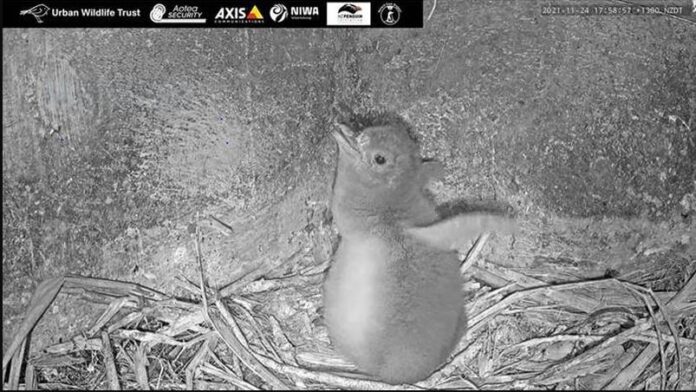Source: NIWA – National Institute of Water and Atmospheric Research
Two kororā chicks – also known as little blue penguins – have hatched in Wellington. They were born in a protective nest box in Evan’s Bay, set up by NIWA and Places for Penguins, in partnership with the Urban Wildlife Trust.
It is the first time since the nests were installed over 20 years ago that chicks have hatched at this site. The public have been watching them via a YouTube livestream thanks to high-resolution cameras installed in their nest.
However, concerned viewers soon alerted the Urban Wildlife Trust to the deteriorating health of one of the adults. A few days later, one of the chicks sadly died, and the other’s life hung in the balance. This follows a spate of abandoned and failed nests throughout New Zealand this year.
Dr David Thompson, a seabird ecologist at NIWA, highlights the hurdles these little birds must go through to successfully raise young: “Breeding for kororā can be a stressful time because they need to find food for both themselves and their chicks, with one adult remaining at the nest while the other hunts. This can leave them prone to exhaustion, illness, or predation.
“Other factors could also be impacting their chance for survival, such as warming seas, which may be pushing their food source further out to sea. Frequent storms, like those we’ve seen in the past few weeks, can also cause sediment to wash into the harbour, perhaps making it difficult for kororā to locate food in the water column. There are many things at play, so it’s important we do further research into these little animals to help them thrive and improve their chances in the future”.
Kororā are a nocturnal bird found around New Zealand’s coasts and grow to only 35 centimetres tall – the smallest species of penguin in the world. They tend to be monogamous, sharing incubation and chick-rearing duties.
Tony Stoddard of the Urban Wildlife Trust said that one adult was left alone for 10 days while its mate was finding food and trying to get home: “We were delighted when these chicks hatched but one adult was left alone for a long time. Its health deteriorated and it had no ability to feed the chicks by itself. We were devastated when one died but thankfully the other parent finally returned, and the remaining chick seems to be doing well.
“The natural world can be unforgiving. And the human induced impacts from climate change, like warmer seas and more frequent storms, make their lives even harder.”
He went on to talk about why simple things like the YouTube livestream can help protection efforts for Korora: “We want to connect people to the nature on their doorstep and fuel efforts to protect our precious native species. That’s why it’s great that anyone with an internet connection can follow their progress and feel part of the lives of these amazing animals”
The Kororā Cam livestream is viewable on YouTube (Urban WildlifeTrust WildCams) https://www.youtube.com/channel/UCLizlM6gpaVHTKPo7spoqlA.



